Work Starts on Redeveloping 150 Vacant Homes
Homes MKE aims to create new homeowners, improve neighborhoods.
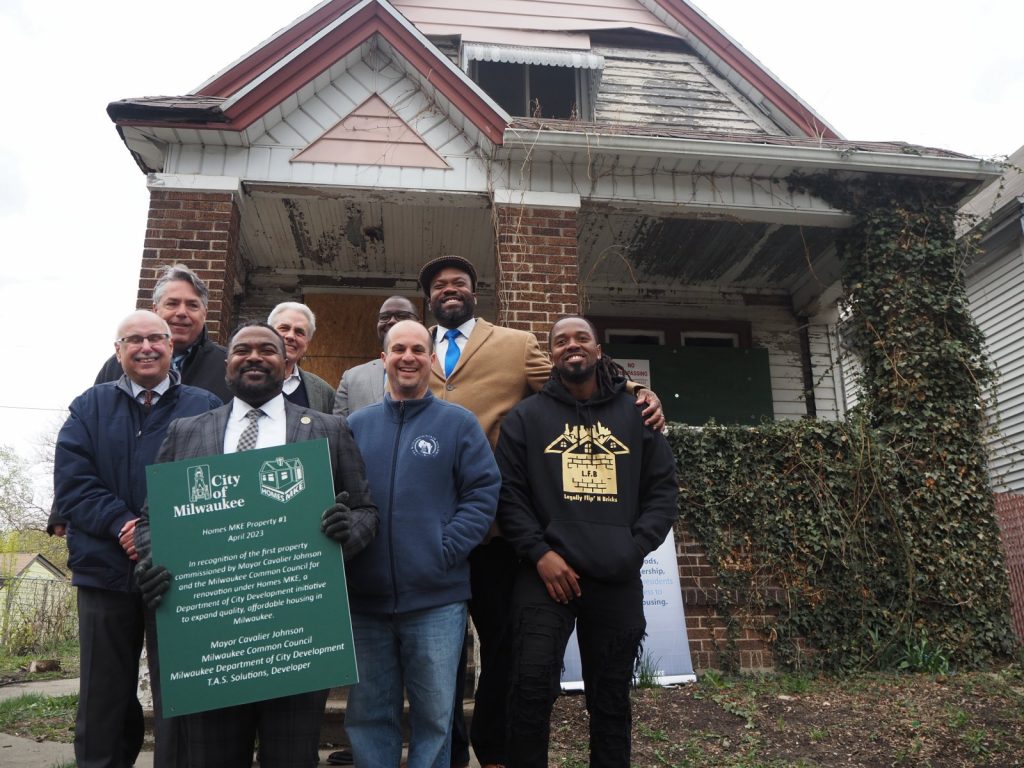
Front – Ald. Mark Borkowski, Lafayette Crump, Ald. Jonathan Brostoff, Kelton Buford . Rear – Ald. Michael Murphy, Ald. Robert Bauman, Ald. Mark Chambers, Jr. and Ald. Russell W. Stamper, II
City of Milwaukee leaders and several small developers gathered Wednesday to celebrate the start of a $15 million project designed to redevelop 150 vacant homes, create nearly as many new homeowners and transform neighborhoods.
Known as Homes MKE, the effort will take vacant, dilapidated properties acquired via property tax foreclosure and transfer them, with a subsidy, to participating small developers. The resulting homes will be sold at affordable rates, leased affordably or placed into lease-to-own programs.
“After hard work and preparation, we are off and running,” said Department of City Development Commissioner Lafayette Crump while standing outside one of the first five houses that will be redeveloped. “We are working to ensure Milwaukeeans have access to the quality, affordable, stable housing they need.”
The Common Council funded the program in October 2021 with $15 million from its $394.2 million American Rescue Plan Act grant. The first development teams were announced in September.
“The collaboration right here is awesome,” said area Alderman Russell W. Stamper, II, while standing in front of the large crowd gathered outside the house, 2845 N. 16th St.
“It has good bones, though right now it doesn’t look that,” said Alderman Robert Bauman, who was credited by his colleagues for inspiring the program and pushing for a much larger funding allocation. “This property will be essentially brand new when it is renovated.”
The city will sell the houses to development teams for as little as $1, provide a development subsidy estimated at $75,000 based on the renovation cost estimates and grant a $5,000 workforce subsidy. The subsidy, unique to each property, will cover the expected gap between the final sale price and the larger cost of rehabilitating the property.
“They will become a beacon of hope in a neighborhood rather than a symbol of blight, disinvestment and deterioration,” said Bauman.
“This opportunity checks all boxes for me personally because I get to do what I do best, which is renovate houses,” said T.A.S. Solutions partner Kelton Buford. His firm, led by himself and his mother Teresa Smith, will work on the 16th Street house. “This is such an exciting time for Milwaukee. This is exactly what our city needs, which is affordable housing in the neighborhoods.”
Houses in the program are mostly located in an area bounded by W. Silver Spring Dr., W. Lincoln Ave., the Milwaukee River and N. Sherman Blvd. The aldermanic districts with the most city-owned homes are located on Milwaukee’s near North Side.
Stamper said 50 of the homes would be in his aldermanic district, which he calls the “fabulous 15th.” The 15th District has long held the highest poverty rate in the city.
Walnut Way Conservation Corp. Executive Director Antonio Butts said many positive projects are already happening in the Lindsay Heights neighborhood where the first house is located. “As we have been doing that work, we know there is a lot of work to do,” he said to the applause of area residents in the crowd.
The participating developers are Acts Community Development, Advanced Investors, a partnership of FIT Investment Group and WestCare Wisconsin, Inc., Maures Development Group, a partnership of One 5 Olive and Milwaukee Community Land Trust, a partnership of Rico Love Foundation and Mayfield Properties, Strong Blocks, CME Development, LLC, Ezekiel Community Development Corp., Servant Manor, T.A.S. Solutions and a partnership of Walnut Way, Silicon Pastures II, LLC and Walters Renovations.
Unless the property is sold to an owner-occupant, the house must be developer-owned for at least five years. A deed restriction will require a sold property to be owner-occupied for five years and owners would be required to complete eight hours of home-buyer counseling through either Acts Housing, Housing Resources, Inc. or the United Community Center.
“These homes are all going to serve as a place to generate real wealth,” said Ald. Michael Murphy.
Stamper, Bauman and Murphy were joined by colleagues Mark Borkowski, Jonathan Brostoff and Mark Chambers, Jr. Mayor Cavalier Johnson, who brokered the funding deal when he was still on the council, was said to be in Madison meeting with members of the Wisconsin State Legislature.
By the end of the week, the city expects to have transferred the first 10 properties to development teams. Rehabilitation work is expected to take approximately six months per property. A scope of work must be prepared for each property and reviewed by DCD before the title is transferred. Lead service line replacement is included with each project and the Milwaukee Metropolitan Sewerage District is funding the cost of sewer lateral replacement.
Bauman and Murphy said the program is a long-term response to the 2008 housing crisis and Great Recession. The city acquired a wave of properties in the following years through property tax foreclosure and Bauman said it was important to treat them as assets.
DCD is focused on first transferring the houses that have been in its inventory the longest.
The 16th Street house, built in 1893, was acquired by the city in 2016 and marketed for sale for six years at $2,500. It sports a placard on the front that serves as a warning to the Milwaukee Fire Department and boarded-up windows. It’s also been a frequent target of illegal dumping, as its permit history and a walk to the backyard illustrate.
But beyond creating new affordable housing, others see opportunities for future employment for Milwaukee residents.
“When I look at these affordable, boarded-up properties, everyone that knows me knows that I see a classroom,” said Jim Gaillard of Ezekiel CDC. The organization frequently participates in nonprofit and city housing initiatives and focuses on skills and job training. Gaillard previously called the finished houses Ezekiel creates a “byproduct” of the organization’s core work.
To access the workforce subsidy, a developer’s workforce must include a minimum of 300 hours of work completed by unemployed or underemployed city residents. In addition, at least 50% of the work must be completed by employees residing in the following ZIP codes: 53204, 53205, 53206, 53208, 53210, 53212, 53215, 53218 or 53233. A living wage of at least $12.21 per hour must be paid.
House
Press Conference
If you think stories like this are important, become a member of Urban Milwaukee and help support real, independent journalism. Plus you get some cool added benefits.
Political Contributions Tracker
Displaying political contributions between people mentioned in this story. Learn more.
- April 22, 2019 - Cavalier Johnson received $50 from Lafayette Crump
- February 20, 2016 - Cavalier Johnson received $250 from Robert Bauman
- July 20, 2015 - Russell W. Stamper, II received $50 from Lafayette Crump
- October 15, 2014 - Robert Bauman received $100 from Lafayette Crump
- September 8, 2014 - Robert Bauman received $100 from Lafayette Crump
Eyes on Milwaukee
-
Church, Cupid Partner On Affordable Housing
 Dec 4th, 2023 by Jeramey Jannene
Dec 4th, 2023 by Jeramey Jannene
-
Downtown Building Sells For Nearly Twice Its Assessed Value
 Nov 12th, 2023 by Jeramey Jannene
Nov 12th, 2023 by Jeramey Jannene
-
Immigration Office Moving To 310W Building
 Oct 25th, 2023 by Jeramey Jannene
Oct 25th, 2023 by Jeramey Jannene


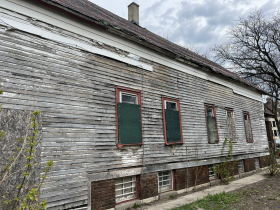
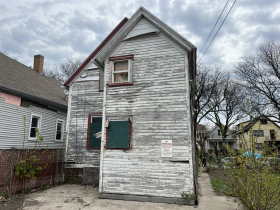
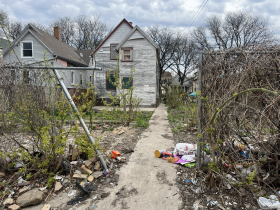

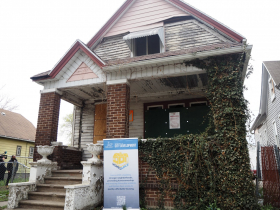
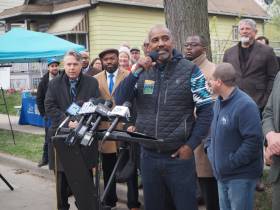
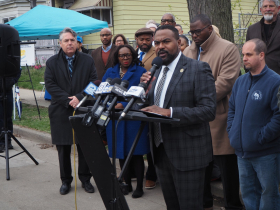
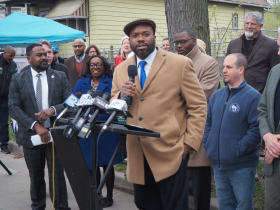
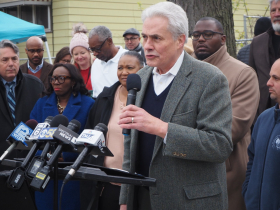
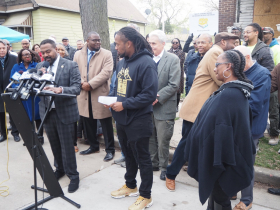
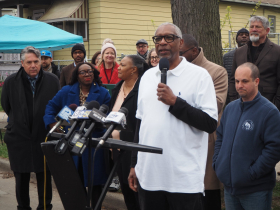



















This is what the city government needs to do! A GREAT IDEA! Home ownership – creating people invested in the community. AGAIN A GREAT IDEA.
Why did it take so long, and how can we move forward faster? What about Habitat for Humanities helping out? Could Milwaukee Public School Students or even local college students get involved in helping to improve houses – helping homeowners?